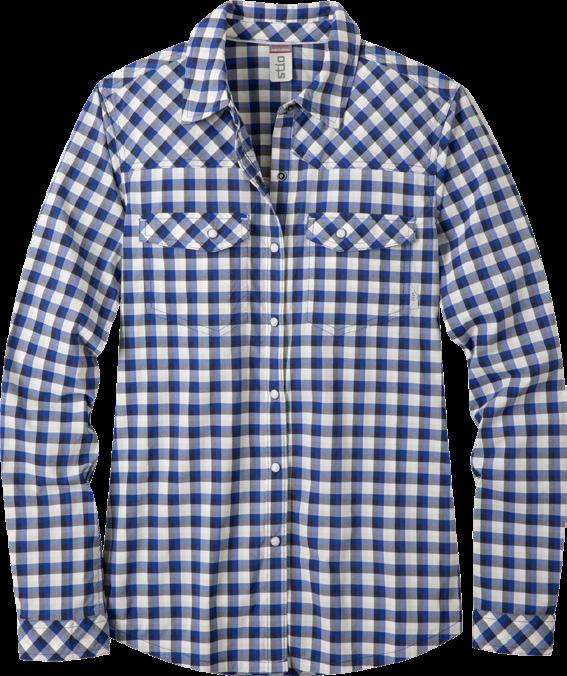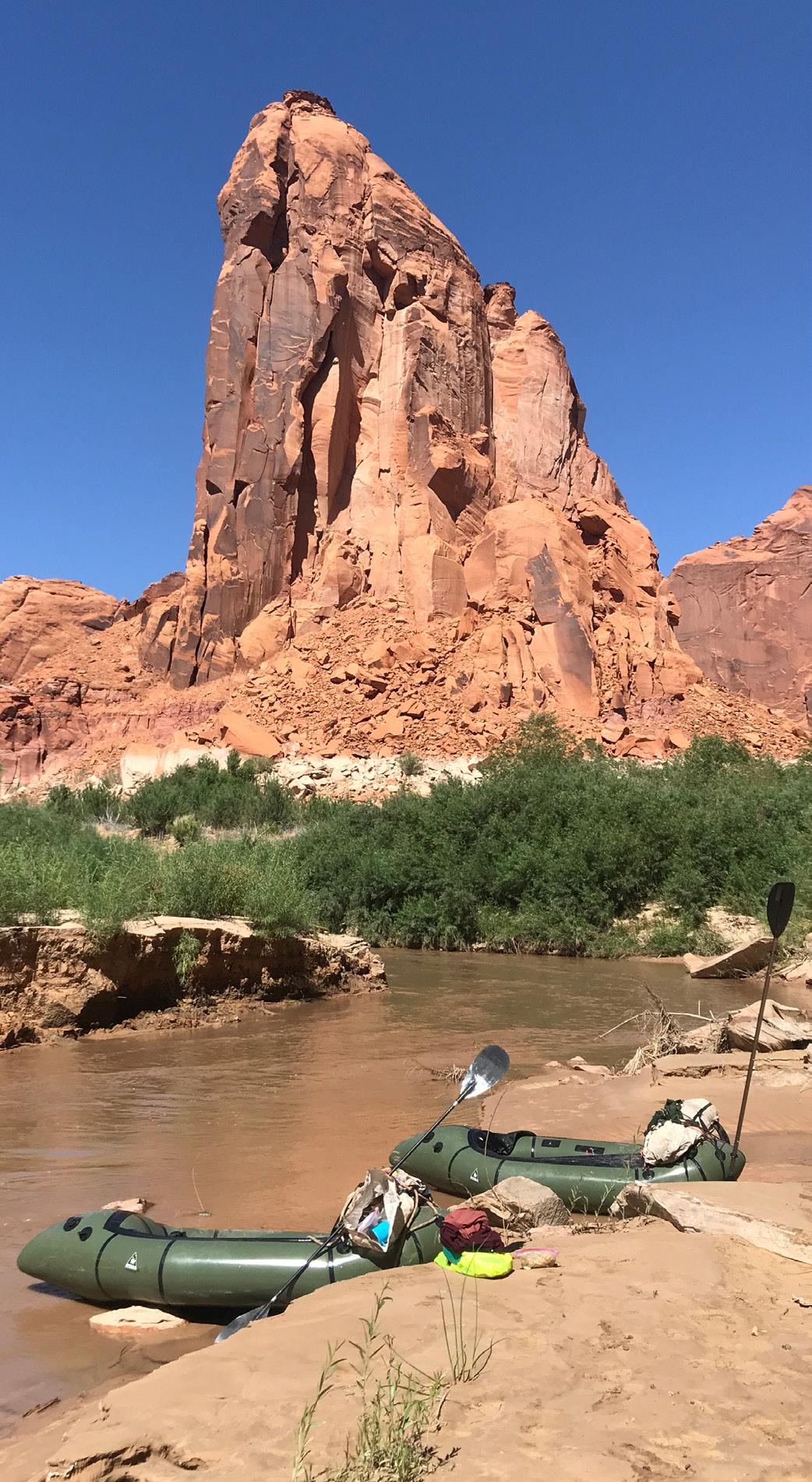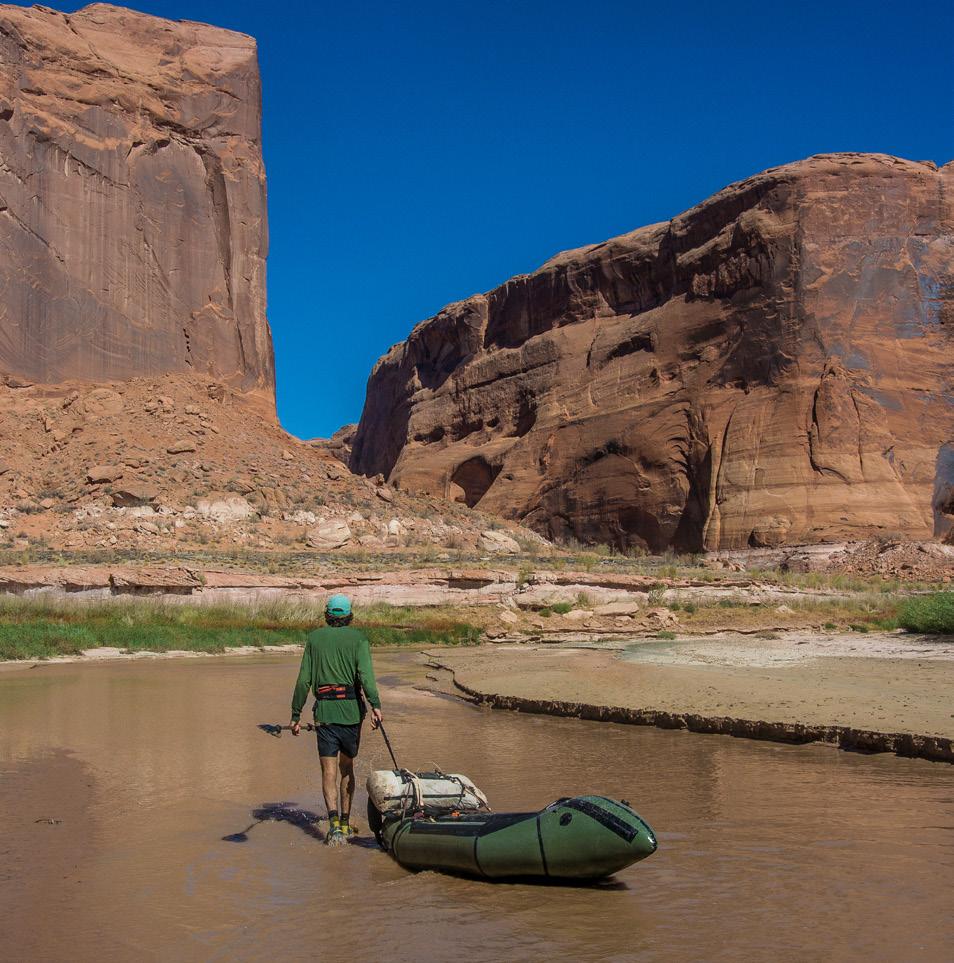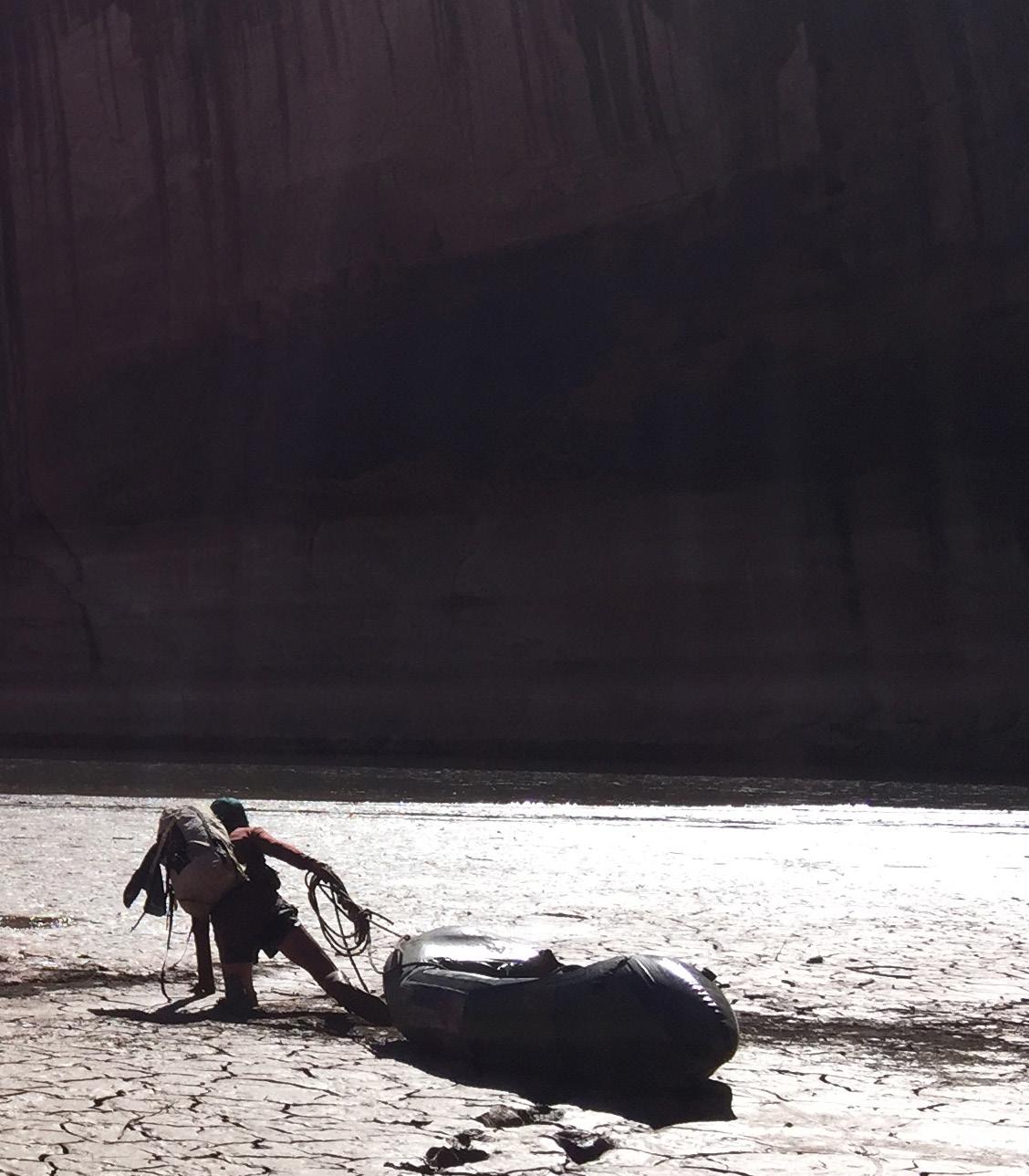
14 minute read
GEAR BIN
STIO EDDY Long-sleeve Shirt (men’s and women’s)
If you can only pack a single shirt, our recommendation is the Eddy. One of our testers took the two-week challenge with the Eddy, meaning he wore it every day for two weeks. He sported it for hiking, stand-up paddling, mountain biking, climbing and spring skiing. When there weren’t sports involved, he wore it for Zoom meetings, to the grocery store and to pick up take-out food.
His conclusion? The Eddy LS (long sleeve) is the ultimate go anywhere, do anything shirt. The athletic cut, with plenty of room in the shoulders and not too much bagginess in the chest never inhibited movement or range of motion. The soft nylon/polyester blend material has a slight stretch, nice if you’re paddling, climbing or lifting a keg out of the back of your truck.
And while the Eddy is 100% synthetic (read quick-drying and wrinkle-free), it has the drape and appearance of its cotton cousins. While the material looks casual, it’s highly technical, with a water-resistant finish and UPF 50+ sun protection.
The tail is 30 inches (men’s medium) so you can wear it untucked or cowboy style. Both shirts are finished with faux-pearl snap closures and adjustable cuffs with three snap adjustments that are easy to roll up. The men’s medium is a featherweight 8 ounces although the shirt doesn’t feel wispy. Plus it stuffs down to the size of a grapefruit if you are stashing it in your pack. The men’s version has 16 colorways to choose from, the women’s collection offers nine. www.stio.com

$ 129 00 ARMORED OUTDOOR GEAR RatSack Cache Bag

You learn quickly that food needs protection when your camp gets ransacked by scavengers. Rats and mice smelling a meal will gnaw through tents. Raccoons, ravens, squirrels and roaming campsite dogs will rip apart plastic garbage bags to get to leftovers. Nobody wants that. Enter Armored Outdoor Gear, the creator of the RatSack.
Manufactured in Flagstaff, Arizona, the RatSack concept is simple. The knitted stainless steel mesh bags when hung off the ground keeps critters from getting to any odoriferous contents stored inside. The steel mesh is unchewable, won’t rust or break apart.
The RatSack comes in four sizes, each made of knitted stainless steel with a tough 2-inch hook-and-loop Velcro closure at the top. Aside from keeping scavengers off your food, the RatSack doubles as a bag in which you can cool drinks in a stream or river. The Sack Pack, an off-shoot of the RatSack, is equipped with straps and a zipperedclosure for use at festivals or events requiring clear, see-through bags.
For our testing, we followed the manufacturer’s instructions to hang a foodfilled RatSack between trees at a campsite, which resulted in one frustrated magpie. And when we learned we could test the RatSack in a mouse-infested shed while the owner of the shed placed mouse traps in the corners, we took advantage. We put an enticing bag of snacks in a RatSack and placed it on the floor of the shed over three days. While the mouse traps collected a daily harvest of mice, the RatSack received a daily shaking to rid it of mouse turds. The bag of food remained untouched and the RatSack intact. www.armoredoutdoorgear.com
ULTRALIGHT, SMALL, MEDIUM, LARGE
$ 39 99
TO
$ 49 99 AIRE BaKRaft Hybrid Packraft

The packraft has opened an exciting new world of adventure to explorers. Rather than hiking or biking in and then back out, we can now head into the mountains on foot or bike and either paddle a lake or paddle out on a stream or river. What fun!
These individual-sized inflatable boats are designed to be light and small enough to fit in a backpack or on a bike and durable enough to withstand the rigors of hard use. The AIRE BakRaft takes that design and one-ups it with a self-bailing floor and an I-beam construction that resists folding in technical rapids. Also, AIRE didn’t take its basic kayak design and cut materials to save weight. The company actually tweaked the shape of the BAKraft to cut smoothly through all types of water.
At 7 feet long and 8.5 pounds, the BAKraft Hybrid is a scaled-down version of the BAKraft Expedition, which is 10 feet in length and weighs 12 pounds.
We didn’t get an opportunity to test the BakRaft Hybrid but we do own AIRE boats, a cataraft and a duckie, so we know the quality of the brand. The BakRaft series is made in the U.S. with a Vectran fabric shell, has the urethane AIREcell internal bladder system and thermos/heat-welded seams, and has streamlined in-field repairability. It comes with a seat, inflation bag, hand pump, thigh straps and repair kit. www.aire.com
BAKRAFT HYBRID $ 1,649 00
BAKRAFT EXPEDITION $ 2,199 00

BOAT WALKER A TERRIFYING TALE OF A WEST WITHOUT WATER
Packrafting the Escalante River at low water provides a sneak peek of a possible apocalypse
The quicksand took me to my knees, and I sank deeper as I flailed my arms and legs. This tortured landscape, once a pristine river corridor, is now entrapped in silt from a declining human-caused lakebed. As the sediment crept into my membranes, I surrendered by lying across its surface.
The Escalante River meanders far beyond any road or human dominion. For 90 miles the river twists and turns through a sandstone corridor lending itself to a unique riparian habitat. Since Grand Staircase-Escalante National Monument was established in 1996, extensive invasive plant eradication and cooperation from local ranchers has helped to restore Escalante’s canyons and watershed.
These are some of the most pristine and beautiful waterways of the Southwest, connected to what is considered one of the last rivers to be mapped in the Lower 48. Today the Escalante is no longer a secret, affirmed by the presence of Boy Scouts, families and tourists visiting its canyons.
Yet it has a secret: though it is undammed and flows freely in its upper reaches, its lower end is being humiliated at the hands of humankind.
To get to this impasse was no small task. The work began even before starting the hike through bone dry washes, thorny invasive species and cow shit. The nearest town of Escalante, Utah, is one of the most remote in the west. From there it still takes hours of driving the wash boarded Hole-In-The-Rock road before turning toward the trailhead down the sandiest Jeep trail imaginable.
To create a shuttle for a loop route, my hiking companion volunteered the use of his motorcycle. This saved us very little time, as our load was not suited to the deep sand. In short order the sand overtook the tires and launched both of us and our heavy packs into the dirt, face first. Feeling like I’d been punched in the gut, I spit sand from my teeth and looked out at the Mad Max world awaiting ahead.
From my seat in the dirt, I hitched a ride down the final stretch of road to the trailhead with a passing search-and-rescue vehicle. With little option, my partner walked the motorcycle most of the remaining distance.
The loop itself was a perceived thing of beauty. The objective: to backpack from the trailhead down to the Escalante River in the afternoon, make camp, and then float past the confluence of the Escalante and Colorado rivers to Lake Powell the next morning. Arriving at Lake Powell, we’d paddle two miles to our takeout, pack up our packrafts and hike a tributary canyon back up to my Jeep.
It sounded fun, despite the fact that we had not checked the water flow. We did not realize the prime packraft season had long passed on this desert river and we were deep into a drought year.
At the river we excitedly inflated our Alpacka rafts. We launched into a few inches of water, occasionally using paddles and feet to help scoot along. As the water thinned we started walking alongside to keep the rafts from dragging along the bottom. Eventually, the boats had to be pulled with a rope like a leashed animal. Not 10 miles later, the river disappeared altogether, and we were left with little choice but to carry our boats.
story & photography by MORGAN SJOGREN
BOAT WALKER


TOP LEFT: Early optimism had us ready to paddle. However, no paddles required! TOP RIGHT: Imagine a world without water. CENTER: Eventually, the boats had to be pulled with a rope like a leashed animal. CENTER RIGHT: The sediment creeps into the author’s membranes. BOTTOM LEFT: Boat Walkers: The art of walking long distances while carrying and dragging a boat. BOTTOM RIGHT: Drifting through the Escalante River corridor.


Though we should have been nearing the confluence with the Colorado River, I was face down, literally crawling across a new humanmade ecotone—a dying lake bed. The flies buzzed around my sunburnt face. Resting my cheek against the cool mud that smelled of mold and must, the momentary respite provided a semblance of quenched thirst. Not expecting to need water on a float of a freaking river, an hour or more passed without water in searing heat. I contemplated licking the mud. I imagined a world without water. I also imagined a world without food, as the remaining rations were a package of mustard-flavored sardines, black coffee and half a pack of cigarettes. I never needed to smoke, but this trip affected my mind. The southwest is well into a decade of drought and heat escalation. The Glen Canyon dam, which helped create this foul mess at the edges of Lake Powell, was built in 1963 to store water and generate hydroelectric energy for major cities in Arizona, California and Utah. From my vantage point on the ground, I looked up at the I could not help “bathtub ring,” a white line stained across the sandstone but laugh (or wall reflecting a high-water maybe curse) mark from long ago. While it is a relief to consider the at this bizarre possibility of this canyon disconnected world we live in. and others reemerging from their underwater burial, it is haunting to lie almost 90 Modern life in the Wild West can feet beneath obvious net water losses. In fact, over recent years Lake Powell has be stranger than science fiction. experienced its lowest water levels since its pre-dam era as a living river. Could someone in Phoenix turning on a faucet imagine us, slogging through the muck dragging boats where the not-so-eternal water source used to be? I pulled my face off the ground, and one hand at a time I caressed the surface. As I gingerly slid my hands across the mud, followed one by one by my shins, in a delicate crawl I was allowed passage. In slowly leaving behind the terrors of the quicksand, I remained aware that there is a beautiful canyon beneath this hostile layer of sludge. The ghastly white mark tracing the canyon walls above is ever-present, serving to remind us of the presence of Lake Powell. It had to be near. With my head down I crawled forward, until I stopped at the sound of a familiar squeal. Perhaps a bird? I looked up to spot a power boat in the distance, expecting the expanse of mud stretching between me and its bow to be a mirage. But there, standing on a deck, a woman in a hot pink bikini stood flailing her arms, making what



sounded like party noises. I risked sinking to rise and wave my arms. “Hey!” The woman shifted her stance and looked toward me.
She motioned to her friends. They pointed and chattered, watching me slog toward the lake shore. As my partner and I drew near, both of us fully covered in thick black mud, I noted several anchored boats. On nearly every boat at least one person took photographs of us, the two swamp creatures approaching shore.
In the midst of the distractions, I realized my paddle fell off of my pack. I floundered back across the muck to retrieve it. My partner, still far behind struggling in quicksand, had yet to look up. I called to him. His response: “This sucks!” Literally.
The boaters had ample time to capture video, post footage to social media and crack open another beer while we labored to the shore. I could not help but laugh (or maybe curse) at this bizarre disconnected world we live in. Modern life in the Wild West can be stranger than science fiction.
At the lake, I shimmied face down and slid into the stagnant, murky water. I drank deeply, not caring whether the water was laced with boat gasoline and human feces. When my partner arrived, we rinsed mud from our bodies and readied our pack rafts. Launching toward the enclave of onlookers, I expected to simply paddle by, thinking only of crossing nearly 2 miles of flat water. I had nothing to say, or so I thought, as we approached the bewildered boaters. They asked if we were OK. I looked up at them lining the deck of the shiny white vessel, and muttered, “Yes. Beer?”
Unbelievably, we are handed a generous six-pack of beer (yet no clean drinking water, although in all fairness it was not the request). After thanking them we paddled off into the seemingly vast and bottomless desert sea − across the grave site of Glen Canyon.
Not even the most elaborate trick (a dam) can convince the Colorado Plateau to retain water in this unnatural way. Even the recordbreaking snowpack in mountain ranges that feed Lake Powell can override unrelenting heat and evaporation. No monkey wrench is necessary to foil the plans of a dam and a lake that was never in nature’s plan.
I chugged my beer and turned to paddle fervently for the next canyon while contemplating where I should cache the extra beer. I could already envision a west without water, or worse, and I knew very well what my last words will be.
MORGAN SJOGREN is a free-range raconteur typically found roaming wild in the Colorado Plateau, but is now quarantined in southwest Colorado. This story is a behindthe-scenes glimpse of her third book, The Best Grand Staircase-Escalante National Monument Hikes (2019).
Refreshment R I V E R T R I P

TIPS FOR A SUCCESSFUL HAPPY HOUR ON THE RIO
Multiday river trips are one of the best ways to celebrate the long, hot days of summer. With a good crew of friends and miles of river to run, there is no shortage of fun and camaraderie to be had on a river trip. Add the element of surprise, and your group is in for a treat.
story & photography by TIONA EVERSOLE
IIn the days leading up to launch, schedule a trip to the store for essentials: snacks, ice and your drink of choice. While stocking up on beer, why not grab the goods for an afternoon happy hour at the same time? The group will thank you for the impromptu ice cold boozy beverage (or mocktail for the sober folks) while floating through some of the most isolated areas in the Southwest. So pick your poison and throw an extra bag of ice in the cooler; here are some tips for executing the ultimate river trip happy hour. Cold drinks and a sandy beach for playing games — the perfect way to relax and take a break from rowing down the Colorado River.
Think Outside the Can
Sure, beers and seltzers are a simple solution for river trip beverages. Chances are, everyone else on the river trip probably thought to bring the same thing. Think bigger than the 30-pack.
Unlike backpacking or bikepacking trips, rafts have the potential to carry a lot of gear. Weight and space typically are not an issue. If a cocktail or mocktail requires several components such as mixers and garnishes, plan ahead and gather all of the ingredients. There is no need to sacrifice the lime wedge or simple syrup for the sake of weight or space.
Shatter-Proof Your Booze
Glass is not your friend on a river trip — it breaks easily and is a hazard for both the boat and its passengers. Purchase liquor and mixers in plastic bottles for a river tripfriendly option. If your spirit of choice only comes in glass, consider pouring the contents of the glass bottle into an empty plastic container. A two-liter bottle is a good option, or you can divvy up the contents of the glass bottle into a few Nalgene water bottles for safekeeping. Stainless steel bottles are another boat-friendly option, although it is also more expensive than reusing a plastic bottle.






